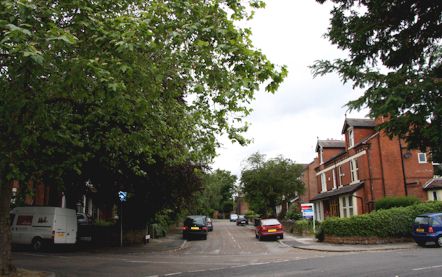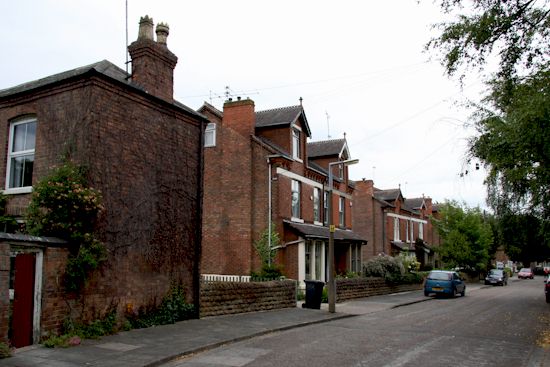


© David Hallam - 1983-2008
|
Grange Avenue, Beeston - by David Hallam
This article is an expanded version of a piece written by the author, that was first published in the Newsletter of the Beeston & District Local History Society in February 1983 and
based on a bundle of documents then recently acquired by the Society. Theses documents include contracts, invoices and letters relating to the construction of the houses on Grange Avenue.
Now, various amendments and corrections have also been made, based on evidence that has become available since it was first written. Notes on the lives of the principals involved and associated
genealogical details and a study of the earlier history of the site have also now been included. |
 The development of Grange Avenue, Beeston - shown here left, viewed from Dovecote Lane - took place to the rear of the residential property comprising The Grange (now the Police Headquarters building), by
the then owner - Edward Smith, a lace curtain manufacturer who had his business in High Pavement in Nottingham, In 1893, we find that he employed A R Calvert to prepare plans and set out the building
plots. The next year, Smith employed William Fletcher, a Beeston builder, to make the road, and James Huckerby, of The City, Beeston, as the architect.
The development of Grange Avenue, Beeston - shown here left, viewed from Dovecote Lane - took place to the rear of the residential property comprising The Grange (now the Police Headquarters building), by
the then owner - Edward Smith, a lace curtain manufacturer who had his business in High Pavement in Nottingham, In 1893, we find that he employed A R Calvert to prepare plans and set out the building
plots. The next year, Smith employed William Fletcher, a Beeston builder, to make the road, and James Huckerby, of The City, Beeston, as the architect.
This was the beginning of a series of contracts with Fletcher who was to build all the houses in the Avenue with Huckerby acting as architect.
The first requirement was to take down the existing gardener’s cottage, stable and carriage house which was situated in the path of the new road, opposite
the end of Dovecote Lane. Fletcher contracted to do this and to rebuild it, largely using the old materials, for £88. 10. 0d . He was to start on 26th February
1894 and complete by 28th April 1894. It is presumably now number 14 on the right at the top of the Avenue. We will refer to this as Contact A.
This cleared the way for the road and for building to commence on the new houses which appear to incorporate the pair of houses which now include a Doctor’s
surgery now between the Police Station and the Methodist Church, These were described at the time as "with backs to Chilwell Road". This pair cost
Smith £1,110 with the contract let on 4th April 1894 for completion by 1st October that year. This will be referred to as Contact B.
Contracts for the rest of the Avenue followed :
| Contract | | Contact Date | Finish | Price |
| C | The detached house | 21 May 1894 | 28 Feb 1895 | £680 |
| D | Next 2 houses S.W. Side | 27 Sep 1894 | 1 Mar 1895 | £560 |
| E | Pair to corner of S.W. Side | 7 Nov 1894 | 20 Mar 1895 | £670 |
| F | 3 Pairs on N.E. Side | 8 Dec 1894 | 1 Sep 1895 | £1980 |
The photograph on the right shows the 3 pairs included in Contract F, viewed from the top of the Avenue. Number 14, on the extreme left of the photo, was probably the house
built on the site of the gardener's cottage (Contract A).
During the course of the various contracts, Smith paid directly for some of the materials and deducted the amounts from the contract amount; in addition he
paid various ‘extra’ items. The invoices from local businesses that survive as a result include those from W M Greening (Painter, Decorator, etc) of Queens Road, William Watson
(Tile, Stone, etc merchant) of Station Road, Turner & Booth (Stone Masons) of Chilwell Road, The Beeston Gravel Pit Club and Charles Moult (Builder) of Stapleford.
|

|
 |
Two things stand out when reading the papers, Edward Smith was evidently a careful business man who handled the financial details personally and generally
struck a hard bargain and, on the other hand, William Fletcher took on a job which stretched him financially. The contracts provided for specific payments
at key stages of construction whilst, in fact, Fletcher was paid a much larger number of smaller amounts, ‘on account’, during construction. A note from
Huckerby in October 1894 starts "Mr Fletcher says he his (sic) hard up and as (sic) a bill to meet ... ". And again, in February 1896, Fletcher
writes, "please send by my son cheque for my last draw pair villas, I have £80 to find within the next few days - bills falling due and I am still confined
to my bed ".
Smith had built the houses to let and they were advertised in the Nottingham press and were quickly taken up. It is difficult to fit the names exactly to the
specific house but, on the evidence in the surviving documentation, the tenancies would appear to be:
| B | Chilwell Road | Clarke & ‘A.U.S’ |
| C | Detached House | Possibly ‘Miss Carter’ |
| D | 1st pair on S/W Side | Johns & Leighton |
| E | 2nd pair on S/W Side | Johnson & Belcher |
| F | N/E Side | Start, Preston, Clarke, Spencer, Lewis(?) + A.N.O |
As we have seen, on Grange Avenue itself - leaving aside the pair of houses on Chilwell Road - 10 semi-detached houses. a detached house and a cottage were built
on Grange Avenue itself. This fits precisely to the evidence on the ground today and to that presented in the 1901 census - if we leave aside the house on the top end of NE side (now number 14) which is more probably part of the
original Grange complex.
In 1901, the enumerator found 12 households and seems to have recorded them sequentially, starting at the corner of West End, up the SW side to the end of the avenue, down the NE side and finishing on the
corner with what was then Church Street. Unfortunately, the houses were not then numbered but, nevertheless, based on the probable enumeration sequence and cross-checking against the documents, we can be fairly sure that the houses
were then occupied as follows :
| Number | Contract | Head of Household | Occupation | Family Members | Servants |
| 1 | E | James H Clarke | Lace manufacturer | Annie L, his wife, Annie E.M(14), Harry C.V.(9) | 2 |
| 3 | E | John B Johnson | Railway clerk | Marie, his wife, Norman F.B (23, professor of music), Mabel F,E (21, violinist)
Maud M.E (20, art student), Bernard C (19, electrical student), Percy F.W. (18, student mechanical engineer) | 1 |
| 5 | D | Percy O Venn | Hosiery manufacturer | Clara, his wife | 1 |
| 7 | D | William J Johns | Commercial traveller | Sophia E, his wife, Hilda G (12), Sophia Downing (mother-in-law) | 1 |
| 9 | C | Priscilla & Rebecca Carter | Living on own means | | 2 |
| 14 | A | William Papworth | Domestic gardener | Jane, his wife | |
| 12 | F | William T Start | Commercial traveller | Elizabeth A, his wife | 1 |
| 10 | F | Aubrey H Topham | Lace Manufacturer | Emily, his wife | 1 |
| 8 | F | Albert E W May | Commercial Traveller | Sarah I, his wife, margaret E. M,(1) | 1 |
| 6 | F | Elizabeth Clarke | (Widow) | Mary J Bagnall (Companion) | |
| 4 | F | Frederick Spencer | Commercial Traveller | Susan, his wife, Elsie R.(11), Harold F.W.(8), Gladys M (6), Doris M. (6), Susannah Ray (mother-in-law) | 1 |
| 2 | F | George Seals | Life Insurance Company Superintendent | Mary F.C, his wife | 2 |
Grange Avenue had clearly established itself as a fashionable place to live for both established and aspiring businessmen and their families. Today it remains an attractive residential street, essentially unspoilt and providing a relatively quite
environment whilst still conveniently placed for access to Beeston's amenities.
It seems that Edward Smith and his team got it right !
Now, click here to something about the life stories of those who built Grange Avenue
or : Click to Learn More of the Origins of the Site of Grange Avenue
or : Return to Top of This Page
© David Hallam - 1983-2008
|
 |
 The development of Grange Avenue, Beeston - shown here left, viewed from Dovecote Lane - took place to the rear of the residential property comprising The Grange (now the Police Headquarters building), by
the then owner - Edward Smith, a lace curtain manufacturer who had his business in High Pavement in Nottingham, In 1893, we find that he employed A R Calvert to prepare plans and set out the building
plots. The next year, Smith employed William Fletcher, a Beeston builder, to make the road, and James Huckerby, of The City, Beeston, as the architect.
The development of Grange Avenue, Beeston - shown here left, viewed from Dovecote Lane - took place to the rear of the residential property comprising The Grange (now the Police Headquarters building), by
the then owner - Edward Smith, a lace curtain manufacturer who had his business in High Pavement in Nottingham, In 1893, we find that he employed A R Calvert to prepare plans and set out the building
plots. The next year, Smith employed William Fletcher, a Beeston builder, to make the road, and James Huckerby, of The City, Beeston, as the architect.